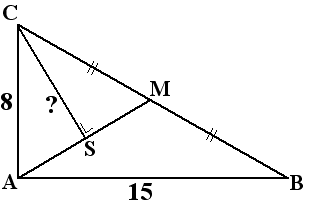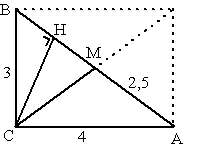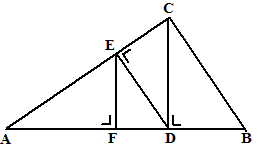|
|||||
| 1. | CB =
√(152 + 82) =
17 CM = MB = 81/2. Dan is ook AM = 81/2. (teken er maar een rechthoek ABDC omheen, dan is M het middelpunt daarvan) Oppervlakte AMB = 1/2
• 15 • 4 = 30 |
|
|||
| 2. | Oppervlakte hele
driehoek: 1/2
• 4 • 3 = 6 Oppervlakte CMA: 1/2 • 4 • 11/2 = 3 Oppervlakte CMB = 6 - 3 = 3 CM = MB dus driehoek CMB is gelijkbenig. 3 = 1/2 • 21/2 • CH CH = 2,4 HM2 = CM2 - CH2 = 2,52 - 2,42 = 0,49 dus HM = 0,7 Oppervlakte CHM is 1/2 • 0,7 • 2,4 = 0,84 Dat is 0,84/6 • 100% = 14% van de hele oppervlakte |
|
|||
| 3. | CD • 10 = 6 • 8
geeft CD = 4,8 DB = √(62 - 4,82) = 3,6 AD = 10 - 3,6 = 6,4 oppervlakte ADC: 6,4 • 4,8 = 8 • DE DE = 3,84 EC = √(4,82 - 3,842) = 2,88 AE = 8 - 2,88 = 5,12 oppervlakte ADE: 6,4 • EF = 5,12 • 3,84 EF = 3,072 |
|
|||
| 4. | Noem de schuine zijde
c en de onbekende rechthoekszijde a 302 + a2 = c2 30a = 24c (oppervlakte) dus a = 0,8c 302 + (0,8c)2 = c2 900 + 0,64c2 = c2 900 = 0,36c2 c2 = 2500 c = 50 De oppervlakte is dan 0,5 • 50 • 24 = 600 |
||||
|
© h.hofstede (h.hofstede@hogeland.nl) |
|||||


